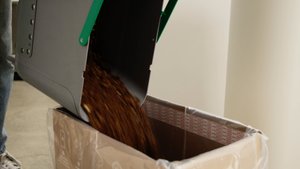Mill includes everything

A second life for food
Want to put your scraps to the highest possible use? Mill will have your dry grounds picked up and turned into food for chickens. Got other plans for them? Pickups are totally optional.

Parts and maintenance
You’ll never have to pay for an air filter or a repair. And when your bin reaches the end of its life, it won’t become trash. We’ll retire it responsibly, and provide you with a shiny new one.

Dedicated support
That is, we have a dedicated in-house support team — so you can chat with real experts easily — and we’re dedicated to ending food waste, and making your life easier.

Impact reporting
You won’t need to guess how much food you’ve rescued, or how many chickens you’ve fed. You’ll get robust reports — and high fives — to celebrate the impact of all that Milling.
Pricing
Psst. You should really go with the annual plan. It’s about a dollar a day, all in, with the bin. But we get it if you want to take it month by month. The good news is you can switch anytime.
$29.99/month
$359.88 billed annually
$49.99/month
Cancel anytime
Questions? We’ve got answers
Shipping times vary so please check our pricing page for the latest shipping estimates.
We'll give you a heads-up when your Mill is ready, in case you need to change your info.
Cancel anytime before your bin ships or during the money-back guarantee for a complete refund.
Shipping times vary so please check our pricing page for the latest shipping estimates.
We'll give you a heads-up when your Mill is ready, in case you need to change your info.
Cancel anytime before your bin ships or during the money-back guarantee for a complete refund.
The Mill kitchen bin turns kitchen scraps into dried, ground-up food that we call Food Grounds. Food Grounds are still food, minus the water, bulk, odor, and ick. Food Grounds aren’t compost. Compost is produced when microbes digest kitchen scraps, which takes weeks or months, not hours — despite what others might say. While Food Grounds can be made into compost or added to your garden, it is a delicate process that can result in mold, cause odors, and attract pests. Sending us your Food Grounds is not required, but we highly recommend it because it is the most practical way to keep your kitchen scraps in the food system, as we work to turn them into food for chickens.
The Mill kitchen bin turns kitchen scraps into dried, ground-up food that we call Food Grounds. Food Grounds are still food, minus the water, bulk, odor, and ick. Food Grounds aren’t compost. Compost is produced when microbes digest kitchen scraps, which takes weeks or months, not hours — despite what others might say. While Food Grounds can be made into compost or added to your garden, it is a delicate process that can result in mold, cause odors, and attract pests. Sending us your Food Grounds is not required, but we highly recommend it because it is the most practical way to keep your kitchen scraps in the food system, as we work to turn them into food for chickens.
The food we throw away is still food. It takes a lot of land, water, fertilizer, and effort to get food from the farm to our tables — so it’s important for our food to stay in the food system. There are ways to make the best use of food that’s uneaten. First, feed people. Then, feed animals that produce food for people. Both options align with the EPA’s food recovery hierarchy and the hierarchy of destinations for achieving United Nations Sustainable Development Goal Target 12.3.
We receive shipped Food Grounds at our feed manufacturing facility where we turn them into a safe chicken feed ingredient through inspection, screening, heating, and blending.
We’ve worked through most of the necessary scientific and regulatory processes to distribute our nutritious chicken feed ingredient commercially. We’ll share more on our progress later this year!
The food we throw away is still food. It takes a lot of land, water, fertilizer, and effort to get food from the farm to our tables — so it’s important for our food to stay in the food system. There are ways to make the best use of food that’s uneaten. First, feed people. Then, feed animals that produce food for people. Both options align with the EPA’s food recovery hierarchy and the hierarchy of destinations for achieving United Nations Sustainable Development Goal Target 12.3.
We receive shipped Food Grounds at our feed manufacturing facility where we turn them into a safe chicken feed ingredient through inspection, screening, heating, and blending.
We’ve worked through most of the necessary scientific and regulatory processes to distribute our nutritious chicken feed ingredient commercially. We’ll share more on our progress later this year!
We designed Mill to dry and grind food scraps as efficiently as possible using integrated sensors and custom algorithms that determine the quickest runtime needed to transform your food scraps into dry grounds. Your energy use will depend on the amount and kind of kitchen scraps you add to it. We estimate the bin will use around 1 kilowatt-hour (kWh) of electricity per day, averaged over multiple weeks of usage (if you generate around 1.5 lbs of kitchen scraps per day). Today, that’s about the same amount of energy per day as an energy-efficient dishwasher, but with software updates, the bin will keep getting better and more efficient over time.
The cost of energy will depend on your local energy rates — you can check your energy bill to see how much you pay per kilowatt-hour (kWh). At $0.20 per kWh (approximately the national average), that’s about $6 per month.
Want to use less energy? Try limiting liquids by doing things like straining wet foods before adding the solids to the bucket.
Big picture: based on our preliminary study, you can avoid about a half-ton of greenhouse gas emissions per year with a Mill service plan. Instead of filling the air with methane, your kitchen scraps are turned into food for chickens, going right back into the food system. To learn more about the climate impact of an annual Mill service plan, click here.
We designed Mill to dry and grind food scraps as efficiently as possible using integrated sensors and custom algorithms that determine the quickest runtime needed to transform your food scraps into dry grounds. Your energy use will depend on the amount and kind of kitchen scraps you add to it. We estimate the bin will use around 1 kilowatt-hour (kWh) of electricity per day, averaged over multiple weeks of usage (if you generate around 1.5 lbs of kitchen scraps per day). Today, that’s about the same amount of energy per day as an energy-efficient dishwasher, but with software updates, the bin will keep getting better and more efficient over time.
The cost of energy will depend on your local energy rates — you can check your energy bill to see how much you pay per kilowatt-hour (kWh). At $0.20 per kWh (approximately the national average), that’s about $6 per month.
Want to use less energy? Try limiting liquids by doing things like straining wet foods before adding the solids to the bucket.
Big picture: based on our preliminary study, you can avoid about a half-ton of greenhouse gas emissions per year with a Mill service plan. Instead of filling the air with methane, your kitchen scraps are turned into food for chickens, going right back into the food system. To learn more about the climate impact of an annual Mill service plan, click here.
The kitchen bin

By signing up for updates from Mill, you agree to our Privacy Policy.
